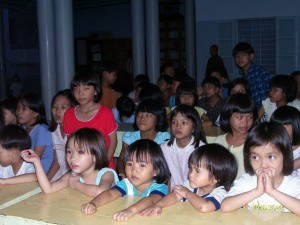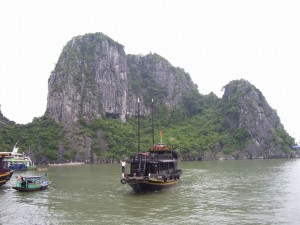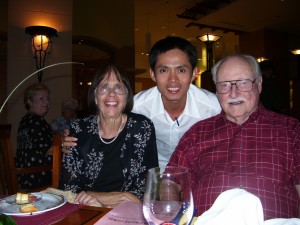A LAST LOOK AT VIETNAM
A TOUR OF MODERN VIETNAM
This is the last in a series of articles about traveling in Vietnam
A LAST LOOK AT VIETNAM
By Charles N. Steven
Photos by Dolores Seidman
As our bus leaves for the airport at 6:30 in the morning, Hanoi is wide awake. Bicycles and the echoing sounds of motorbikes begin to fill the streets. Many people are outside exercising, some walking, others busy at calisthenics. Groups bend their bodies with the graceful motions of Tai Chi. What is most interesting to me is the number of people playing badminton, rackets swinging and shuttlecocks flying over nets strung up between trees or poles. It is clear that the Vietnamese value exercising. All this activity combined with their vegetable and seafood diets keeps them slim and trim. It appears that the only overweight people in Vietnam are the tourists from other countries.
Our bus passes the lake where John McCain descended in his parachute during the Vietnam War, and we are soon on the outskirts of town. We pass a large industrial complex made up almost entirely of Japanese corporations. People stream to work, mostly by foot, an endless line of them moving toward the industrial buildings. This is part of the new Vietnam, plenty of work and income.
Out near the airport we come upon more of the old bouncy castle for sale ways, men plowing with water buffalo, women slashing at ripe wheat stalks with sickles, everyone working at the production of rice. And planted in these same rice fields along the road are huge billboards advertising modern products.
In the middle of these ancient fields, like a futuristic island, is Hanoi’s 21st century airport with its immaculate waiting rooms and glittering shops. We board a sleek Vietnam Airlines Airbus 321, leaving the terminal right on time for Bangkok.
After take off I have my last views of Vietnam—small villages, rice fields, a broad muddy river and winding through them all, a modern super highway.
As our plane climbs up through the tropical air, clouds and haze begin to obscure the land below. The only images of Vietnam I possess now are those in my mind, my memories. Curiously, most of them are of beauty and wonder, anything negative such as withering, humid heat and the danger of crossing streets being left behind.
Dolores and I talk about our impressions of Vietnam. Still vivid in my imagination are the monument-like mountains rising out of the sea at Ha Long and the beach resort near Hai An where coconut palms grow out of the white sands, small waves tumbling on the beach. I will never forget the spectacular view of Saigon from our high hotel window, the magic of just being there. High on our list is the orphanage near Hue where we interacted with the young children. We remember their deep brown eyes, their excitement at our coming, their need for love and affection. Dolores held them and nestled them in her lap. We recall a walk by ourselves at night in Hanoi, the brightly lighted stands where women sold moon cakes in honor of the Autumn Festival. Dolores treasures her memories of the staged wedding ceremony near Saigon where the bride and her colorfully dressed attendants arrived by boat.
Then there was the reality of a tropical deluge, the sound, smell and energy of the lashing rain. The Mekong River was only a word in the newspaper to us until we saw its coffee with cream water, clumps of water hyacinth floating by, small boats with eyes painted on their prows plying the water in both directions, fishnets strung like great spider webs near the muddy banks, even its musty tropical smell.
We can’t help but remember the remnants of the Vietnam War, now nearly forty years in the past. We saw the modern-looking Presidential Palace in Saigon that became the nerve center of the war and the nearby hotels where the war correspondents stayed. We walked on the sands of China Beach where war weary G.I.s often went to relax, noted the fuel storage tanks at the former U. S. airbase at Danang and the protective barriers for American planes at the Saigon Airport. We walked down an alley to examine the wreckage of an American B-52 bomber protruding from a small lake.
We also toured the Cu Chi tunnels where Viet Cong soldiers lived and advanced southward, and the Viet Cong cemeteries that hold the graves of those men, row on row of them. Seeing these cemeteries and thinking about the Vietnam Memorial in Washington D.C. with the names of 58,000 dead Americans, and witnessing the peace and vitality of Vietnam today, makes one ponder the long term value of wars.

A visit to the orphanage at Hue touched our hearts.

The views at Ha Long were unforgettable.

Our guide "Ocean" who taught us so much about Vietnam.



